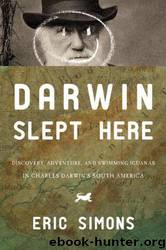Darwin Slept Here: Discovery, Adventure, and Swimming Iguanas in Charles Darwin's South America by Eric Simons

Author:Eric Simons
Language: eng
Format: mobi, epub
Tags: Life Sciences, Nature, Science, Science & Technology, Regional, Essays & Travelogues, General, Biography & Autobiography, South America, Evolution, Natural history, Travel
ISBN: 9781590202999
Publisher: Penguin
Published: 2010-06-29T00:00:00+00:00
Darwin’s was the second voyage of the Beagle to South America. The first trip departed England in 1825 under the command of Captain Pringle Stokes. Like many other travelers, Stokes found Patagonia dreadfully dull. Faced with the idea of more time there, he shot himself. FitzRoy was his flag lieutenant, and he took over the Beagle and set off to survey Tierra del Fuego. Almost immediately, a group of Fuegians stole one of his whale-boats. FitzRoy gave chase but never recovered the whale-boat and instead took hostages, hoping that this would force its return. Much to his surprise, however, the Fuegians appeared satisfied with that bargain. He later traded another family some beads and buttons for a boy, and, with four indigenous people on board, FitzRoy seized on the idea that he would take them back to London with him, have them educated, and return them a few years later. He gave the three men and one woman the names York Minster, Boat Memory, James Button, and Fuegia Basket, and soon they were meeting the queen, ice-skating, and learning to eat with utensils.
Although Boat Memory died of an illness shortly after arriving in England in 1830, the others boarded the Beagle with Darwin a year later and set off for South America, along with a missionary, to convert their friends back home. “Jemmy” Button was the “universal favourite,” according to Darwin, and he remembered Jemmy sympathizing with his seasickness. “He used to come to me and say in a plaintive voice, ‘Poor, poor fellow!’” Darwin wrote. “But the notion, after his aquatic life, of a man being sea-sick, was too ludicrous, and he was generally obliged to turn on one side to hide a smile or laugh.” York Minster, the oldest of the group, was mostly quiet and reserved; Darwin described him as “taciturn” but “violently passionate” when excited. Fuegia Basket was the only female, and Darwin described her as a nice girl and a quick learner.
All the Fuegians taken by FitzRoy except York Minster were part of a tribe called the Yamana. The Yamana were semi-nomadic, living in small, self-contained family groups, and building small huts near oyster beds along the coast and then moving when the oyster supply gave out. They went back and forth between locations, returning to old huts after intervals long enough to allow the oyster stock to replenish. They also clubbed cormorants and seals, fished, and speared the occasional guanaco. They didn’t wear clothing, and smeared themselves with seal grease to stay warm. They carried all their valuables with them in canoes, including torches brandished to help keep their fires alive, and when there was a big event, like a whale washing ashore or an English boat landing, they would all gather in their canoes, build their huts (it took only an hour or two), and hang out.
The Yamana communicated with each other by lighting signal fires along the coast—Magellan saw these in the 1500s and named the place Tierra del Fuego or “Land of Fire” in Spanish.
Download
Darwin Slept Here: Discovery, Adventure, and Swimming Iguanas in Charles Darwin's South America by Eric Simons.epub
This site does not store any files on its server. We only index and link to content provided by other sites. Please contact the content providers to delete copyright contents if any and email us, we'll remove relevant links or contents immediately.
How to Read Water: Clues and Patterns from Puddles to the Sea (Natural Navigation) by Tristan Gooley(3372)
Full Circle by Michael Palin(3350)
Into Thin Air by Jon Krakauer(3261)
How to Read Nature by Tristan Gooley(3213)
In Patagonia by Bruce Chatwin(2830)
The Lost Art of Reading Nature's Signs by Tristan Gooley(2586)
A Thousand Splendid Suns by Khaled Hosseini(2582)
Don't Sleep, There Are Snakes by Daniel L. Everett(2529)
Venice by Jan Morris(2496)
City of Djinns: a year in Delhi by William Dalrymple(2489)
The Songlines by Bruce Chatwin(2471)
L'Appart by David Lebovitz(2439)
The Queen of Nothing by Holly Black(2436)
The Big Twitch by Sean Dooley(2365)
Tokyo Geek's Guide: Manga, Anime, Gaming, Cosplay, Toys, Idols & More - The Ultimate Guide to Japan's Otaku Culture by Simone Gianni(2291)
Iranian Rappers And Persian Porn by Maslin Jamie(2137)
A TIME OF GIFTS by Patrick Leigh Fermor(2135)
INTO THE WILD by Jon Krakauer(2134)
Come, Tell Me How You Live by Mallowan Agatha Christie(2082)
